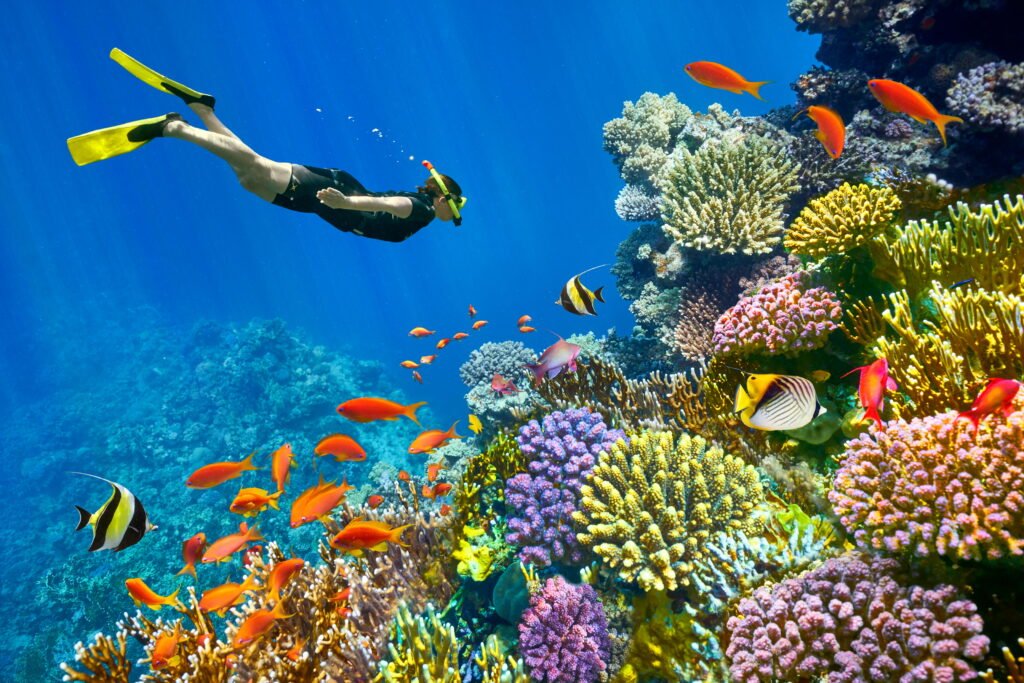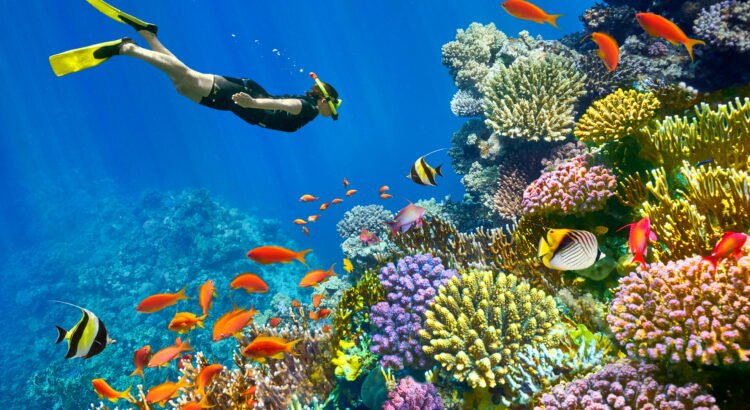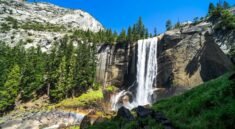
Australia is a land of remarkable contrasts. From the fiery red sands of the Outback to the glittering coral gardens of the Great Barrier Reef, it is a country that stretches the imagination and stirs the soul. Here, ancient geological wonders share space with modern cities, and unique wildlife roams across habitats as diverse as tropical rainforests, alpine highlands, coastal dunes, and dry deserts.
To explore Australia is to journey through some of the most dramatically diverse landscapes on Earth—each with its own story, spirit, and splendor. Whether you’re a nature lover, adventurer, photographer, or cultural explorer, the land down under offers a canvas painted in vivid colors and textured with thousands of years of history, both natural and human.
The Red Heart: Mystical Deserts and Timeless Outback
At the spiritual and geographical center of Australia lies the Outback, a region that encapsulates the country’s ancient soul. Dominated by red deserts, sparse bushlands, and an endless horizon, this is a place where the land tells stories older than time.
One of the most iconic sites is Uluru (Ayers Rock), a massive sandstone monolith that rises dramatically from the flat desert floor. Sacred to the Anangu people, Uluru is more than a geological marvel; it is a cultural and spiritual beacon. As the sun rises and sets, the rock changes color—glowing deep ochre, orange, and purple—a breathtaking phenomenon that leaves visitors in silent awe.
Nearby, Kata Tjuta (The Olgas) offers another extraordinary desert experience with its domed rock formations and mystical walking trails. The Kings Canyon Rim Walk, further north in Watarrka National Park, presents stunning views of sandstone cliffs and hidden oases—a stark reminder that even in the harshest climates, life finds a way.
Driving across the Outback, from Alice Springs to Broome, one can pass through landscapes dotted with termite mounds, ghost gums, and vast salt flats. It is a place where silence is profound, the stars blaze vividly in unpolluted skies, and the sheer scale of the land inspires reflection and humility.
Lush Tropics and Rainforests: The Green Canopy of the North
From red to green, Australia transitions effortlessly. In Far North Queensland, the environment shifts from arid to lush as the Daintree Rainforest emerges—one of the oldest continuously surviving rainforests in the world. Estimated to be over 135 million years old, the Daintree is a living museum of evolutionary biology, home to ancient plant species and rare wildlife like the cassowary and tree kangaroo.
Boardwalks and river cruises allow travelers to delve into the forest’s depths, where the air is thick with humidity and the calls of birds echo through the canopy. Here, nature is not just a backdrop—it surrounds and envelopes you.
The nearby Atherton Tablelands offer fertile highlands, misty waterfalls like Millaa Millaa, crater lakes, and charming rural towns. These highland rainforests, though less famous, are just as enchanting, offering cool respite and opportunities to witness platypuses and other native creatures.
A World Beneath the Waves: The Great Barrier Reef
Arguably Australia’s most famous natural wonder, the Great Barrier Reef stretches over 2,300 kilometers along the northeastern coast. It is the largest coral reef system on the planet and a UNESCO World Heritage Site, visible even from space. But its real magic lies beneath the surface.
Diving or snorkeling here is like entering another world—a realm of vivid colors and alien beauty. Coral formations host an astonishing variety of marine life: clownfish hiding in anemones, majestic manta rays gliding gracefully, and reef sharks patrolling the deep. There are over 1,500 species of fish and 400 types of coral.
Destinations such as Cairns, Port Douglas, and Airlie Beach serve as gateways to the reef. From here, you can take boat tours, helicopter rides, or even spend the night on a floating pontoon under the stars.
But the reef isn’t just about beauty—it’s also a fragile ecosystem under threat from climate change. Responsible tourism and reef conservation efforts are vital to preserving this underwater paradise for future generations.
Coastal Wonders: Cliffs, Beaches, and Islands
Australia’s coastline, stretching over 25,000 kilometers, is a testament to the power of the ocean and the artistry of time. From the rugged cliffs of the Great Ocean Road in Victoria to the sugar-white beaches of Western Australia, the variety is nothing short of astounding.
In the south, the Twelve Apostles, dramatic limestone stacks rising from the Southern Ocean, offer one of the most photogenic scenes in the country. Meanwhile, Bondi Beach in Sydney epitomizes the laid-back surf culture that Australia is famous for. Surfers, swimmers, and sunbathers gather here to enjoy the golden sand, rolling waves, and vibrant social atmosphere.
To the north, the Whitsunday Islands present a tropical dreamscape. Here, you’ll find Whitehaven Beach, often cited as one of the most beautiful beaches in the world, with silica sand so pure it squeaks underfoot. Sailing through the turquoise waters of the Whitsundays is an unforgettable experience, with coral gardens and hidden coves waiting to be discovered.
In the west, the lesser-known but equally spectacular Ningaloo Reef allows you to swim with whale sharks, the gentle giants of the sea. Unlike the Great Barrier Reef, Ningaloo is accessible directly from the shore, making it ideal for more casual snorkelers and families.
The Alpine Experience: Snow and Mountain Air
Though Australia is often thought of as hot and dry, it also has snow-capped mountains and alpine forests. In the southeast, the Australian Alps run through New South Wales and Victoria, with peaks like Mount Kosciuszko, the country’s highest point.
During the winter months (June to August), areas like Thredbo, Perisher, and Falls Creek transform into ski resorts, offering snow sports and cozy mountain lodges. In summer, these highlands become perfect for hiking, cycling, and wildflower spotting. The fresh mountain air and vast vistas provide a serene contrast to the heat and intensity of the deserts below.
Islands and Off-the-Beaten-Path Landscapes
Beyond the mainland, Australia boasts many islands, each with its own character. Tasmania, the island state to the south, is a treasure trove of temperate wilderness, dramatic coastlines, and rich colonial history. The Bay of Fires, with its orange-hued boulders and crystal-clear waters, offers yet another unique landscape, while Cradle Mountain and Freycinet National Park provide incredible hiking and photography opportunities.
Further north, Lord Howe Island is a remote paradise of volcanic peaks and coral lagoons, limiting visitor numbers to preserve its pristine ecosystem. Kangaroo Island, off the coast of South Australia, is known for its abundant wildlife, including kangaroos, sea lions, and koalas, as well as its rugged cliffs and secluded beaches.
Wildlife Across the Land
Australia’s landscapes are matched only by the uniqueness of its wildlife. Nowhere else on Earth can you find creatures like the kangaroo, koala, echidna, wombat, or platypus. Whether you’re on a bush walk, snorkeling a reef, or even driving along a quiet road, wildlife encounters are frequent and thrilling.
Birdwatchers will be amazed by the diversity of species, from colorful lorikeets to wedge-tailed eagles. In the Outback, it’s not unusual to see emus striding across the plains, and at night, quokkas and other nocturnal marsupials come alive in protected sanctuaries.
Marine life is equally rich—dugongs, dolphins, sea turtles, and countless reef fish form part of the dynamic ocean ecosystem.
Conclusion: A Journey Through Earth’s Greatest Contrasts
Australia is more than just a country—it is a continent of wonders, where every landscape tells a different story. From the silent, red deserts where Aboriginal songlines stretch across generations, to the vibrant coral reefs alive with color and movement, this is a place that captivates the senses and expands the soul.
It is a land of fire and water, rock and reef, sand and snow, and its diversity offers not only visual splendor but also deep opportunities for connection—with nature, with ancient cultures, and with the self.
To explore Australia is to embark on a journey through the extremes of geography and the richness of life. Whether you are chasing sunsets over Uluru, diving among parrotfish in the Coral Sea, or breathing in the eucalyptus-scented air of a rainforest, you are part of something vast and sacred.
Here, in this island continent, you don’t just visit landscapes—you become part of them.



